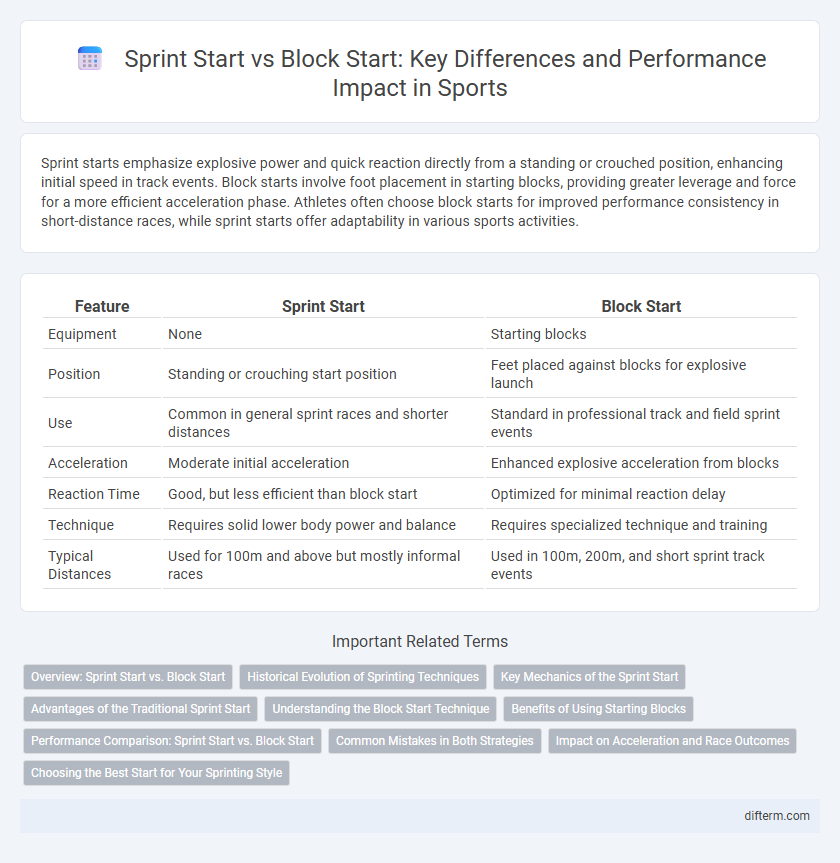Sprint starts emphasize explosive power and quick reaction directly from a standing or crouched position, enhancing initial speed in track events. Block starts involve foot placement in starting blocks, providing greater leverage and force for a more efficient acceleration phase. Athletes often choose block starts for improved performance consistency in short-distance races, while sprint starts offer adaptability in various sports activities.
Table of Comparison
| Feature | Sprint Start | Block Start |
|---|---|---|
| Equipment | None | Starting blocks |
| Position | Standing or crouching start position | Feet placed against blocks for explosive launch |
| Use | Common in general sprint races and shorter distances | Standard in professional track and field sprint events |
| Acceleration | Moderate initial acceleration | Enhanced explosive acceleration from blocks |
| Reaction Time | Good, but less efficient than block start | Optimized for minimal reaction delay |
| Technique | Requires solid lower body power and balance | Requires specialized technique and training |
| Typical Distances | Used for 100m and above but mostly informal races | Used in 100m, 200m, and short sprint track events |
Overview: Sprint Start vs. Block Start
Sprint starts involve athletes launching from a standing or crouched position without equipment, emphasizing reaction time and explosive power. Block starts utilize starting blocks to provide firmer footing and leverage, enabling sprinters to achieve faster acceleration off the line. Elite sprinters predominantly use block starts in short-distance events like the 100-meter dash to maximize initial speed and performance.
Historical Evolution of Sprinting Techniques
The historical evolution of sprinting techniques highlights a shift from traditional standing starts to the widespread adoption of block starts introduced in the late 1920s, which revolutionized race performance by providing enhanced stability and explosive power. Early Olympic competitions primarily featured a standing start, but research and technological advances demonstrated that starting blocks significantly reduced reaction times and improved acceleration. Modern sprinting techniques continue to refine block start mechanics, emphasizing the critical role of biomechanics and training in optimizing athlete speed and efficiency.
Key Mechanics of the Sprint Start
The key mechanics of the sprint start emphasize explosive power and optimal body positioning to maximize acceleration. Sprinters use block starts to generate force through ankle, knee, and hip extensions, ensuring a strong drive phase out of the blocks. Maintaining a forward lean and a rapid leg turnover are critical for transitioning efficiently from the start to full-speed running.
Advantages of the Traditional Sprint Start
The traditional sprint start provides greater flexibility in positioning, allowing athletes to adjust foot placement for optimal power generation. It enhances balance and reaction time by enabling a more natural body alignment compared to the rigid block start. This method reduces the risk of technical errors, making it advantageous for sprinters focusing on explosive acceleration and smooth transitions.
Understanding the Block Start Technique
The block start technique in sprinting enhances acceleration by providing a stable and explosive platform for the athlete's feet, optimizing force application during the initial phase of the race. Proper positioning in the starting blocks involves aligning the back foot near the block's back pedal and the front foot close to the front block, enabling maximal push-off power. Mastery of the block start reduces reaction time and increases stride frequency, contributing to improved overall sprint performance.
Benefits of Using Starting Blocks
Starting blocks enhance sprint performance by providing optimal foot placement and stability, enabling sprinters to exert maximum force during the initial acceleration phase. The fixed position of starting blocks reduces energy loss and improves reaction times compared to a sprint start without blocks. Their use contributes to more powerful launches, increased stride length, and overall faster sprint times in competitive track events.
Performance Comparison: Sprint Start vs. Block Start
Sprint start techniques influence acceleration and overall race performance, with block starts providing greater explosive power and improved reaction times. Block starts enable athletes to generate more force against the ground, resulting in faster initial velocity compared to standing sprint starts. Biomechanical studies show block starts reduce time to reach top speed, making them the preferred choice in competitive sprinting events.
Common Mistakes in Both Strategies
Athletes often falter in both sprint start and block start techniques by misaligning their body position, which compromises power output and acceleration. A common error involves improper foot placement, leading to inefficient force application and slower reaction times. Neglecting the synchronization of arm and leg movements further diminishes overall sprint efficiency and speed.
Impact on Acceleration and Race Outcomes
Sprint starts without blocks emphasize explosive power and immediate stride length, often benefiting athletes in short-distance races by enabling quicker reaction times. Block starts provide a stable base, allowing sprinters to generate greater force during the initial push-off, significantly improving acceleration phases and enhancing overall race performance in events like the 100m and 200m sprints. Studies in biomechanics reveal that sprinters using blocks achieve faster initial velocity and better energy transfer, directly influencing competitive outcomes and race times.
Choosing the Best Start for Your Sprinting Style
Selecting the optimal sprint start depends on individual biomechanics and reaction time, making block starts ideal for explosive power and faster acceleration phases. Sprinters with a strong lower-body drive benefit from starting blocks as they provide stability and leverage, enhancing maximum force application during the initial stride. Conversely, athletes favoring a natural, upright posture may excel with a standing sprint start, promoting quicker transitions into full running form.
sprint start vs block start Infographic

 difterm.com
difterm.com